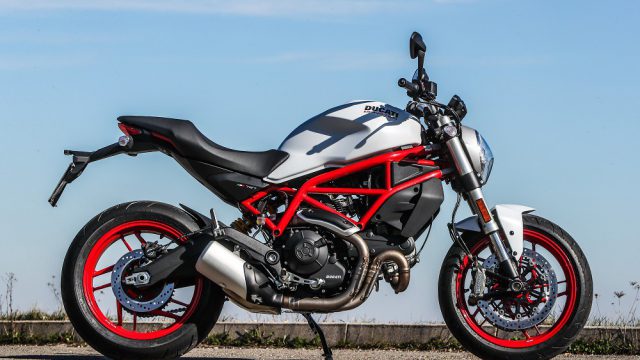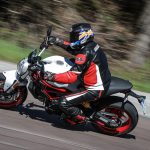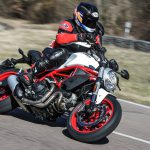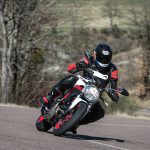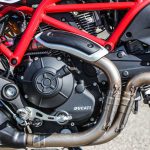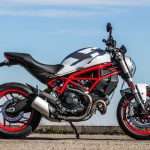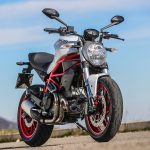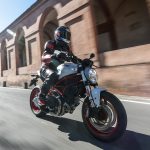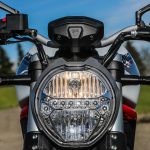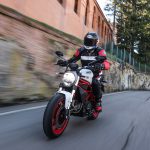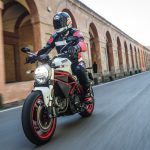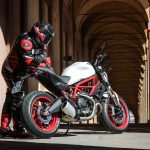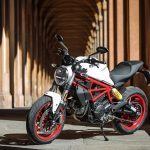First test in Italy of the latest version of Ducati’s most important single model, the entry-level desmodue Monster 797 that underpins the company’s balance sheet
Redeveloped to give smoother acceleration and a broader spread of torque throughout the rev range, with camshafts revised to ensure a linear power delivery. Ducati produces the anti-Scrambler – two distinct routes to entry-level desmodromic fun
When Ducati launched the Scrambler family late in 2014 as a separate brand of low cost models powered by the humblest performing 803cc motor in its desmo V-twin engine line-up, it seemed to spell the end of the line for the entry-level Monster. Especially as the air/oil-cooled desmodue (meaning two-valve desmo, should you need reminding!) Monster 796 version of the Italian brand’s iconic streetrod family powered by the same engine had been replaced in mid-2014 by the Monster 821, which came equipped with the liquid-cooled eight-valve 821cc Testastretta motor, and incorporated the same electronics package as the line-topping Monster 1200. So no more minimalist stripped-out streetfighters of the kind invented by Monster mentor Miguel Angel Galluzzi almost a quarter of a century ago, then? Well – not anymore.
For Ducati has now launched an updated version of its mini-Monster model for 2017, powered by the new Euro 4-compliant version of that same 803cc desmodue motor, making it now the only air/oil-cooled model in the Ducati – as opposed to Scrambler – range, all the remaining Monster variants powered by such engines having now been discontinued. Compared to the Euro 8,650 price tag in Italy (so, including 22% tax) of the lowest-cost Scrambler model with exactly the same engine, the new Monster 797 is available for Euro 8,950 in Ducati red, with a Euro 100 supplement for White Silk or Dark Stealth tints. There’s also a Monster 797 Plus version in all three colours for a Euro 400 supplement, featuring a colour-matched passenger seat cover and flyscreen. All models have extended 12,000 km service intervals.
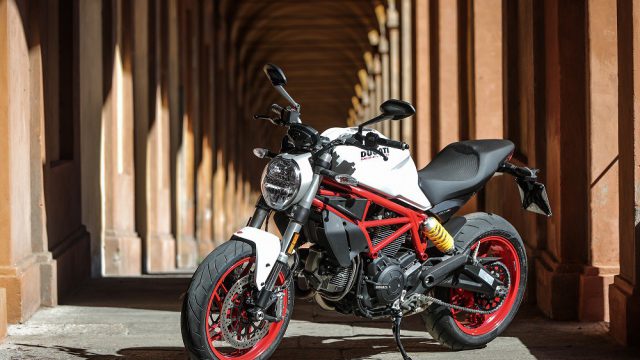
The Monster 797’s 88 x 66 mm 803cc 90º V-twin engine is essentially derived from that which powered the Monster 796, duly redeveloped to give smoother acceleration and a broader spread of torque throughout the rev range, with camshafts revised to ensure a linear power delivery, which is further abetted by the adoption of Ducati’s favoured 11° angle on the valve overlap. Plus, instead of the twin 45mm throttle bodies on the 796, this engine follows the Scrambler version in having just a single 50mm unit for a more fluid power delivery, but with a separate injector for each cylinder positioned south of the butterfly. Moreover, the entire intake package is contained within the airbox, which is wrapped within the specially-designed one-piece tubular steel trellis frame to deliver a really slim motorcycle that feels pretty small and agile to ride.
Compared to the 87bhp/64kW Monster 796 motor, the Euro 4-compliant 797 version of the engine has lost 12bhp in delivering a claimed 75 bhp/55kW at 8,250 rpm (restrictor kits will surely be available as with the Scrambler to limit the power further for A2 licence holders in Europe, or LAMS in Australia), with a comparable drop in peak torque from 78Nm to 69Nm (50.8 lb-ft) at 5,750 rpm. But this nicely positions the new model beneath the 112 bhp/84kW Monster 821 that’s 37 bhp/28kW more powerful than the new 797, making this new bike tailormade for a different audience of possibly – though surely not exclusively – less experienced riders.
The Monster 797 comes devoid of any digital rider aids like traction control, variable riding modes, anti-wheelie or the like, or indeed any other electronics at all beyond the single-stage Bosch 9.1 MP ABS that’s now compulsory under Euro 4 regulations. It’s designed to be a straightforward, accessible introduction to the ducatista experience – light, engaging, simple to use but adequately thrilling, whose appeal comes from that very simplicity, so just hop aboard, turn the key and ride.
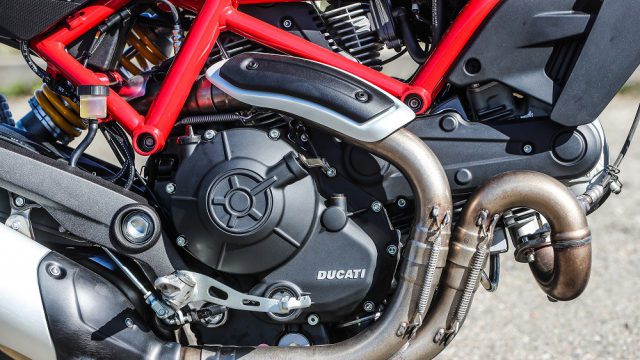
For as a gloriously sunny early spring day spent hustling the 797 through the streets of Bologna and up into the hills behind the city that comprise the foothills of the Appennine mountains confirmed, this is quite a different bike to ride than the same-engined and equally newbie-focused Scrambler. It also arguably looks way more cool thanks to the iconic Monster hunched-forward styling, which the new bike embodies in a subtly refreshened way, complete with that standout spaceframe and trademark round headlamp complete with an LED running light. It has more immediate, sportier steering, which is light and direct without being nervous, and even without a radial master cylinder, the twin 320mm front discs gripped by Brembo Monoblock M4.32 four-piston radial calipers give a superior level of stopping power to the Scrambler’s single disc, without however being snatchy or fierce.
Those twin front discs stop the Monster well, with a soft initial bite before coming on strong – exactly what you need for beginners and experts alike. With the rear 245mm brake with its single-piston caliper not overly strong but sufficiently potent in use, this is an excellent brake package, well able to stop the Monster’s 193kg fully-fuelled wet weight (175kg dry). And there by the way is your price difference between the two bikes explained straight away, with the Monster’s better brakes.
Furthermore, in remapping the ECU to attain Euro 4 compliance for the motor, Ducati’s engineers have dialled out most of the brusque, jerky pickup from a closed throttle in bottom and second gear that has spoilt riding the Scrambler for many people until now. That’s all fixed on the Monster 797 with the same engine and same management system, although acceleration is still pretty immediate in terms of throttle response, just not so snatchy any more at low speeds. And in spite of the reduced power numbers, I promise you this mini-Monster doesn’t feel at all deficient in performance, thanks mainly to the fact that 80% of its peak torque is delivered by just 3,500 rpm. This means that there’s a clean, responsive throttle roll-on from just 2,000 revs upwards in top gear right until the red shifter light on the LCD dash starts flashing at you around 8,500rpm in the run-up to the limiter, although because the torque curve is so flat you don’t have to rev the desmodue motor particularly hard. Anyway, it runs out of grunt at the very top end, but has more than enough midrange punch to bring a smile to your face.
For the Monster 797 is just so nice to ride, with the 4,000-7,000rpm rev band its preferred operating zone, though you can hold fifth gear for miles on end along a winding road, just surfing the broad waves of torque. 6,000 rpm equals 120kmh/75mph in sixth gear, and that’s the Monster 797’s comfortable cruising speed, with no undue vibration – it’s smooth but invigorating, as well as very quiet mechanically, more than I remember the same engine being in the Monster 796. There’s a nice little burble from the 2-1 exhaust exiting behind your right foot, just loud enough to make you smile. Euro 4 regulations may have stifled the sound a little, but the 797 still sounds every bit a Ducati.
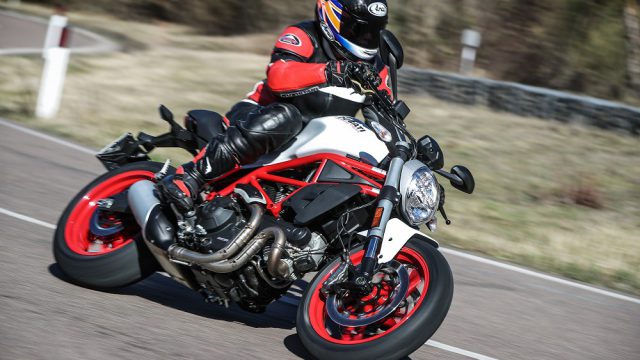
The 797’s six-speed gearbox has a flawless shift action that’s fully up to Japanese quality, and features a cable-operated APTC oil-bath multiplate clutch with a light, precise lever action that makes this an excellent town bike. This has a servo-assisted slipper function that stops you getting the rear wheel skipping if you use a lot of engine braking downhill into a hairpin bend up in the hills, as I repeatedly found myself doing in pursuit of my mate Leo Serafino, whom I was spending the day chasing round the Appennines. He’s Ducati’s mileage tester, fresh back from spending 13 days in France putting 250km on each of the 45 Monster 797 press bikes assigned to the forthcoming riding launch there, during which you might be surprised to hear he didn’t get sick of riding this bike – I mean, you do the maths.
“I ride every single model we make quite extensively, including the Supersport bikes,” said Leo as we sipped a warming cappuccino each at one of his favourite cafés up in the hills, with a magnificent panorama of snow-covered peaks before us. “But even some of my colleagues are surprised how much I enjoy riding this piccolo mostro. It’s just a very honest bike which steers brilliantly, and it’s light and untiring to ride for long distances. It changes direction so well, and the brakes are fantastic, plus it has a very, very low fuel consumption. Many people think of it only as a town bike, to hop from bar to bar on, or to take to the beach. But I enjoy riding it for longer trips like we’re doing today, and the riding position is really great, so comfortable and untiring.”
I can’t argue with any of that, but would only add that one reason the 797 is so comfortable to ride is that the footrests are lower and further forward than on the Monster 821, which combines with the one-piece handlebar’s pulled-back grips to deliver a relaxed, quite upright stance. The 16.5-litre fuel tank is well shaped, so you grasp it cosily with your knees, and the mirrors give a good view, and don’t vibe. Coupled with the not exceptionally tall 805mm seat height – a 20mm lower seat is available as an option, too – and the way the frame narrows behind the fuel tank so that shorter riders will be able to put both feet on the ground at rest, it delivers a riding position that’ll feel naturally confidence inspiring for the less experienced riders who are the smallest Monster’s target audience. Plus, the new chassis has a 7mm shorter wheelbase at 1435mm, which coupled with a 24º rake and just 90mm of trail for the 43mm non-adjustable Kayaba upside-down fork offering 130mm of travel, helps deliver the agility that Leo was enthusing about, yet without any sense of instability if you hit a bump on the angle at speed.
The front suspension is quite firm, but its settings have been well chosen, so that it’s adequately compliant with good feedback from the road surface, in spite of being non-adjustable. But although the Sachs rear shock offset to the left of the cast aluminium double-sided swingarm is adjustable for spring preload and rebound damping in giving 150mm of wheel travel, it did give a sometimes harsh ride, especially over successive bumps or ripples in the road surface.
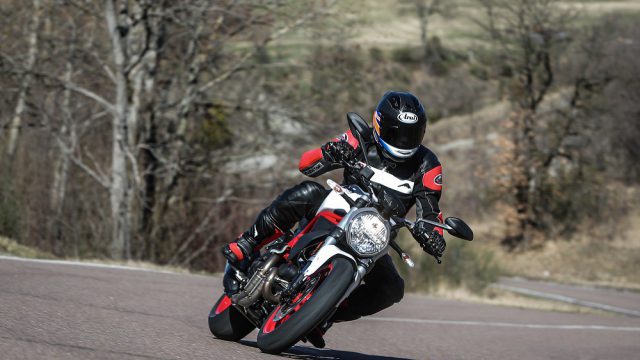
The Pirelli Diablo Rosso II dual-compound tyres fitted are quite grippy enough for the desmodue motor’s relatively humble power delivery, and combine mileage-enhancing durability with constant grip, say Ducati engineers, even in assertive cornering. They employ Pirelli Enhanced Patch Technology/EPT to maximise the contact patch area whatever the lean angle, and FGD/Functional Groove Design to optimise performance in the wet, with a 120/70 ZR17 up front and 180/55 ZR17 at the rear, which is a good compromise size between delivering grip on the angle, and providing the agility that’s such a key feature of the 797’s handling..
Since the removal of the Monster 696 from Ducati’s catalogue, there’s been a clear gap in the Monster range which the Scrambler models don’t really fill. “We see the 797 Monster as appealing to traditional Ducati customers, whereas the Scrambler family is aimed at attracting new riders to our products,” says the 797’s project leader Eugenio Gherardi, whose last gig was heading the R&D team producing the X-Diavel cruiser, and the one before that the Superleggera uber-Panigale: is that a varied professional career, or what?? But he’s right – the 797 eloquently fills this gap as a cool new entry-level Monster for inexperienced riders. It’s accessible, comfortable and easy to ride, as a simpler and less intimidating bike than anything else in the Ducati range right now. But it’s also almost certainly the last air/oil-cooled Ducati model to be catalogued in the range, as opposed to the Scramblers, and for that reason if no other is a significant bike.
For with more than 325,000 different Monster variants manufactured in the past 24 years since the M900 began production in 1993, these have been the lynchpin of the Ducati success story over the past quarter of a century. Without the income and profits generated by successive Monsters, there’d have been no serial World Superbike titles for Ducati in that time – the count currently stands at 14, in the past 29 years – nor any MotoGP race effort, so no Desmosedici for Casey Stoner to beat the Japanese teams to the World title on, as he did in 2007.
These bikes have been Ducati’s cash cow, and even as the Italian marque moves ever upward in terms of performance and specification, with the new generation of V4 Superbikes coming up soon, it needs the humble Monster to keep on clocking up the numbers in the showrooms, and after riding the latest version of the family, I‘d say there’s every probability it’ll keep on doing that in this sector of the market. This latest version of the family is an ideal entry-level bike for newbies, which fulfils its role of being flexible and accessible for them to ride, while providing heaps of fun for more experienced riders, too.
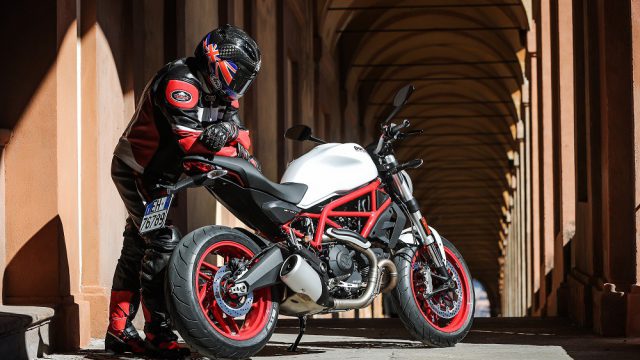
However, in producing this bike I reckon Ducati management has made a nifty problem for themselves, notwithstanding Ing. Gherardi’s rationale. For the 797 is such a cool-looking bike with all the traditional appeal of the Monster’s in-yer-face styling and spritely, satisfying performance, that I can’t help thinking it’s going to take sales away from the Scrambler now that Ducati is offering two distinct routes to entry-level desmodromic fun. I mean – look at it: which one would you rather have if there’s just Euro 300 difference between the two in the price tag, in return for which you also get an extra front brake and radial caliper, plus an upside down fork and Monster styling. No contest – is it??
* * * * *
Photo credit: Milagro/Thomas Maccabelli
